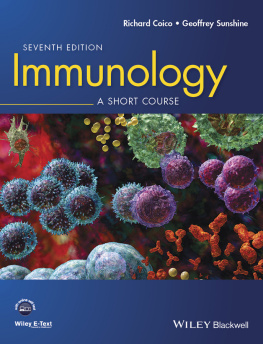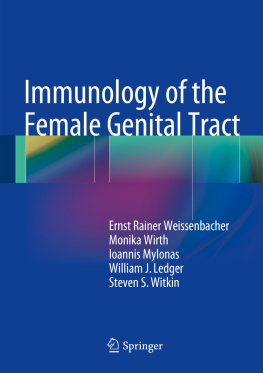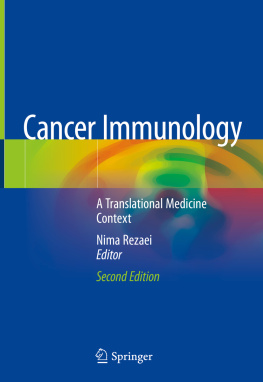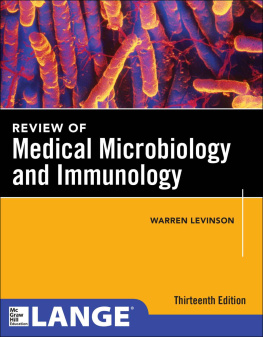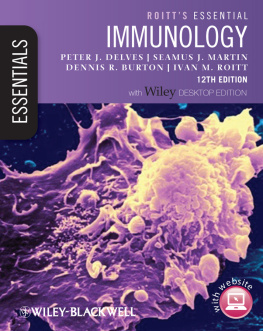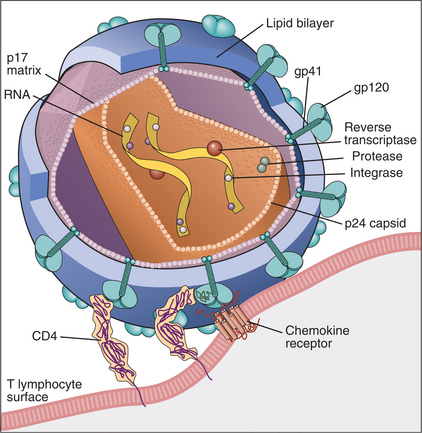PROBLEM-BASED IMMUNOLOGY
Reginald Gorczynski, MD, PhD
Professor, Departments of Surgery and Immunology, University of Toronto and The Toronto Hospital, Toronto, Canada
Jacqueline Stanley, PhD
Course Director and Professor of Immunology, St. Georges University School of Medicine, St. Georges, Grenada
SAUNDERS
Front Matter
PROBLEM BASED IMMUNOLOGY
Reginald Gorczynski, MD, PhD
Professor
Departments of Surgery and Immunology
University of Toronto and The Toronto Hospital
Toronto, Canada
Jacqueline Stanley, PhD
Course Director and Professor of Immunology
St. Georges University School of Medicine
St. Georges, Grenada
Copyright
SAUNDERS ELSEVIER
1600 John F. Kennedy Blvd.
Ste 1800
Philadelphia, PA 19103-2899
Problem-Based Immunology
Copyright 2006, Elsevier Inc.
ISBN-13: 978-14160-2416-3
ISBN-10: 1-4160-2416-6
All rights reserved. No part of this publication may be reproduced or transmitted in any form or by any means, electronic or mechanical, including photocopying, recording, or any information storage and retrieval system, without permission in writing from the publisher.
), by selecting Customer Support and then Obtaining Permissions.
Notice
Immunology is an ever-changing field. Standard safety precautions must be followed, but as new research and clinical experience broaden our knowledge, changes in treatment and drug therapy may become necessary or appropriate. Readers are advised to check the most current product information provided by the manufacturer of each drug to be administered to verify the recommended dose, the method and duration of administration, and contraindications. It is the responsibility of the treating physician, relying on experience and knowledge of the patient, to determine dosages and the best treatment for each individual patient. Neither the Publisher nor the editor assumes any liability for any injury and/or damage to persons or property arising from this publication.
The Publisher
Library of Congress Cataloging-in-Publication Data
Gorczynski, Reginald M.
Problem-based immunology / Reginald Gorczynski, Jacqueline Stanley.
p. ; cm.
Includes bibliographical references.
ISBN 1-4160-2416-6
1. Clinical immunologyCase studies. I. Stanley, Jacqueline. II. Title.
[DNLM: 1. Immune System DiseasesCase Reports. 2. ImmunizationCase Reports. 3. NeoplasmsimmunologyCase Reports. 4. PsychoneuroimmunologymethodsCase Reports. 5. Transplantation ImmunologyCase Reports. WD 300 G661p 2006]
RC582.G67 2006
616.079dc22
2005056314
Acquisitions Editor: William R. Schmitt
Developmental Editor: Kevin Kochanski
Publishing Services Manager: Tina Rebane
Design Direction: Louis J. Forgione
Printed in China
Last digit is the print number: 9 8 7 6 5 4 3 2 1
Dedication
To Pat, Christopher, and Laura
To David and Brian
Preface
The pace of advancement of knowledge in the basic science of immunology and the application of that knowledge into the clinical realms continue to amaze even the most enthusiastic of scientists in the field. Some thirty years ago we had just become used to thinking in terms of acquired immune responses developing from an interaction between two separate lymphocyte populations, B cells and T cells. The old adage from Shaws popular play that we should pay attention to the phagocytes, presaged by Metchnikoffs earlier characterization of the importance of these cells in host resistance, seemed old hat. In the intervening years, how much has changed. Acquired immunity is now understood to be an extraordinarily complex beast, many of whose secrets unquestionably still remain untold. And our evolving understanding of the innate immune system, with the documentation of the intricacy and heterogeneity of newly described receptors on and in cells contributing to innate immunity (toll-like receptors [TLRs] and nuclear oligomerization domain containing proteins [NODs]) has rightly restored Metchnikoff (and Shaw) to a position of preeminence.
The rationale for this volume, as it was for our earlier publication, Clinical Immunology, was based on a need to supply medical students and graduate students with an up-to-date understanding of immunology as it is applied to clinical practice. Our experience, both as students and as teachers, convinced us that a problem-based approach was an ideal one to generate most interest during the learning process itself, and to ensure that what was learned would prove to have some long-lasting value. This new volume represents a major improvement over our earlier book, in that we have now endeavored even more to curtail the introductory basic concepts included in each section and incorporated/embedded most of our objectives into the clinical cases used to highlight the science. Accordingly, the cases described are richer in material and interest, and while many of them highlight comparatively esoteric clinical scenarios, the basic immunobiology behind those scenarios continues to be all the more intelligible because it is seen in these contexts.
We have in addition added one novel section on psychoneuroimmunbiology into this book. This we are sure is new to any clinical immunology text, and especially to one such as ours, using a case-based approach. Given the growing worldwide interest in alternative medicines and the scientific evidence that documents the impact of many physiological systems on the functioning of the immune system itself, the rationale for this new section is, we feel, self-evident.
As before, we hope the reader enjoys working through the problems as much as we enjoyed collating them. We have endeavored to correct errors in fact and typographybut are happy to receive feedback should others strongly disagree with statements they find herein. We would like to acknowledge the help of both Kevin Kochanski and Tina Rebane at Elsevier for their tireless efforts to ensure the publication would be as timely and professional as possible.
Finally, if the reader completes the journey and remains hungry for more knowledge in any or all of the subjects he/she finds herein, we shall have been successful in our goals.
Reg Gorczynski, Jacqueline Stanley
SECTION I
Immunodeficiency Disorders
Introduction
Immunodeficiency disorders can be classified in terms of whether they are inherited (primary) or acquired (secondary), and whether they affect the innate immune system or the adaptive immune system. The complexity of cells and molecules that function in normal host resistance mechanisms of both innate and acquired immunity is covered in brief. Given the significant redundancy in the mechanisms by which normal host resistance to bacterial infection, for instance, is achieved, it should come as no surprise that there is in turn a considerable heterogeneity in the origin (at the cellular and molecular level) of apparently similar clinical presentations. This often makes determination of the etiology of a clinical disorder a puzzle worthy of a Holmes novel.
The cases presented in this section range from the comparatively common (selective IgA deficiency; AIDS) to the seemingly esoteric (bare lymphocyte syndrome). However, in all cases there are a number of details whose mastery will continue to provide the student with an important background understanding of the nature of the development of a normal working mammalian immune system. It is against that background of understanding, that the later sections of the book will have a greater meaning.
Next page

